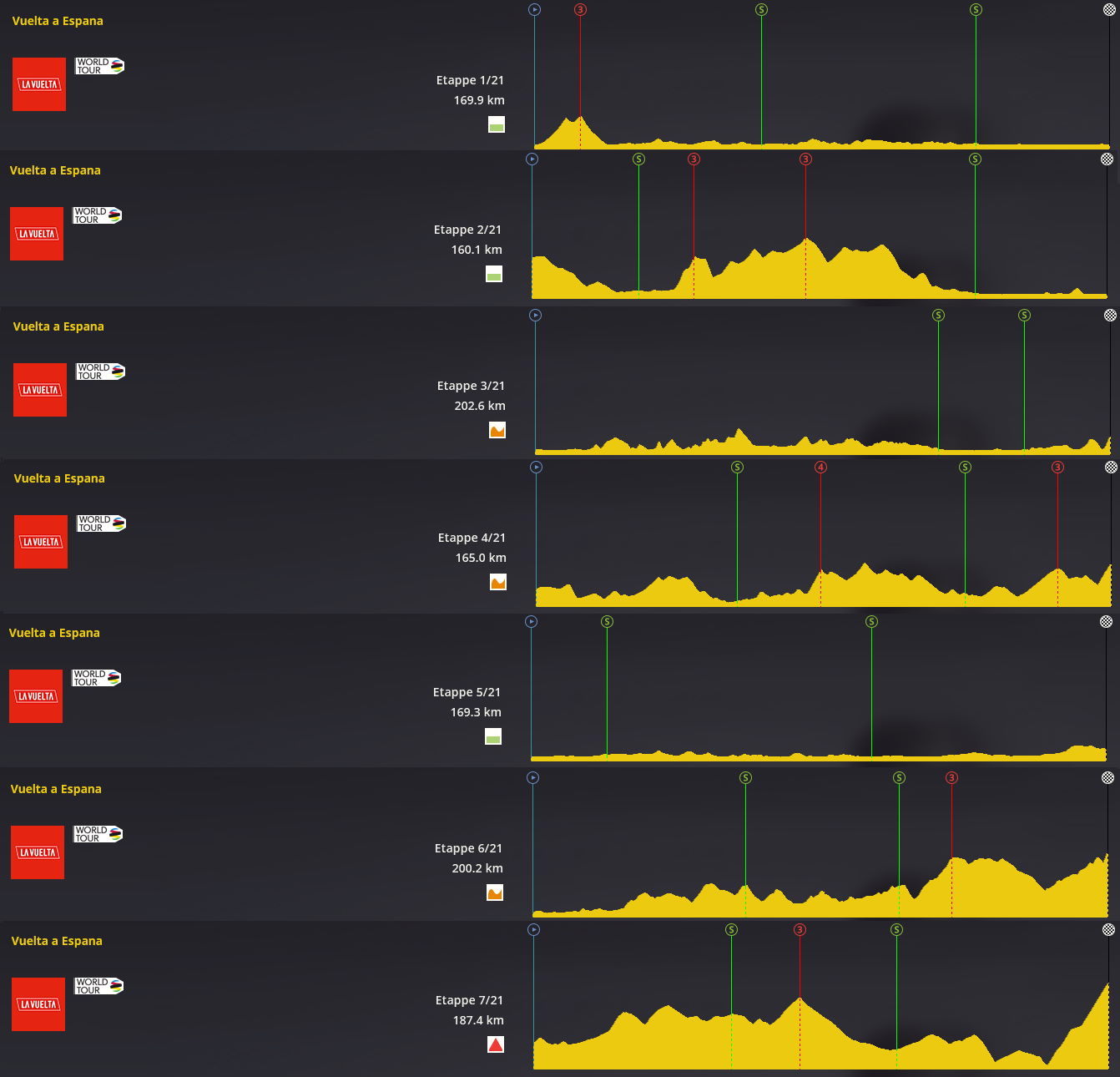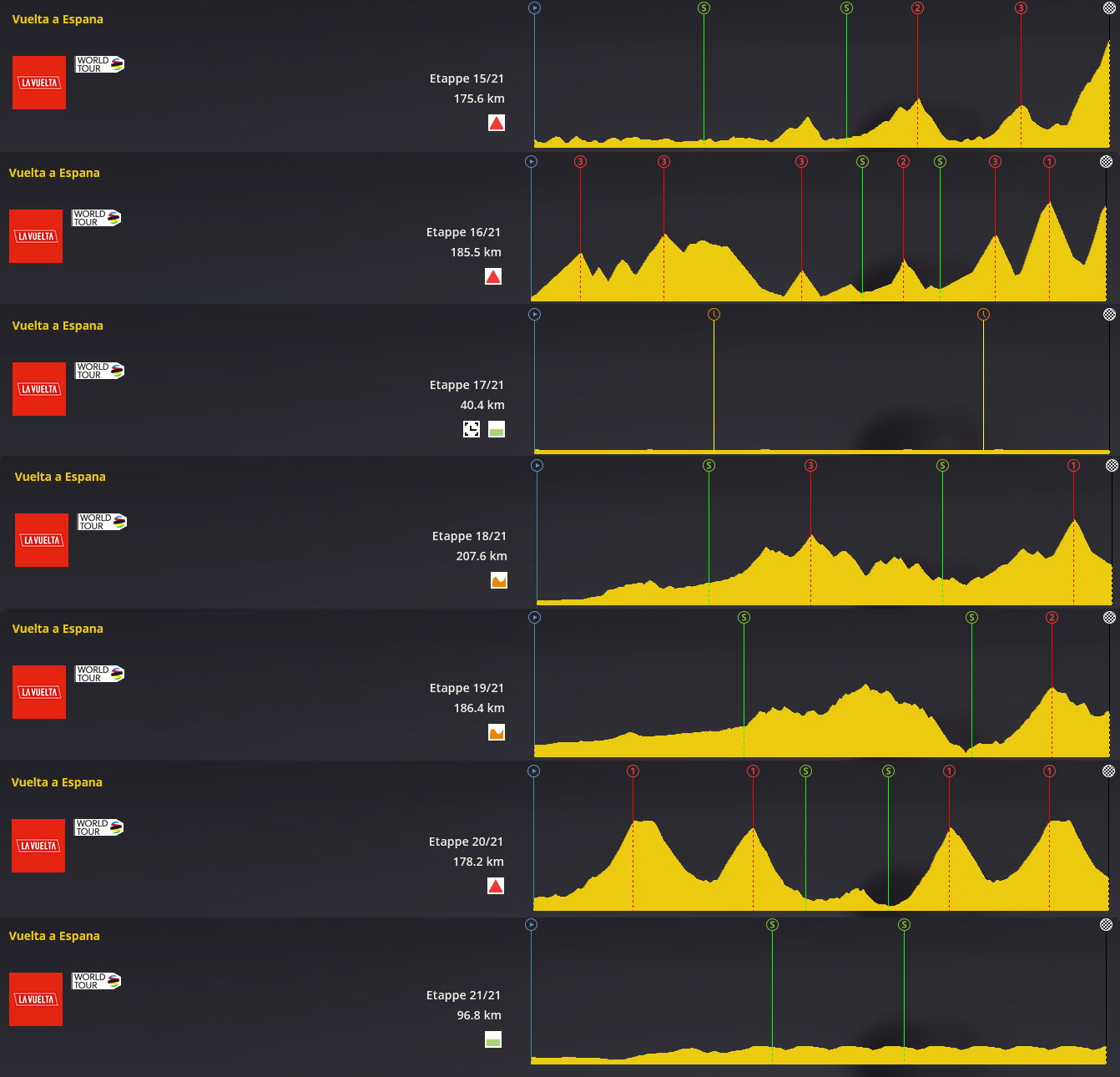Vuelta a España, the Tour of Spain. The 2nd Grand Tour on the MG calendar. Last year the route favoured the pure stage racers that can climb and ride against the clock. What does this year have in store?
Well it looks like the organisers tried to cater to every type of rider, and they may in fact have achieved that. Differing from most years the race starts with a flat stage, rather than with a time trial. So it's a chance for the sprinters to take the first red jersey. The race though gets progressively tougher. A total of 9 uphill finishes means that the contenders will need a good punch at the end of stages. There are 66 km of time trialing across 2 stages, so that will play a factor. There are 4 stages over 200 km in length, but none of those are flat. All have a considarable amount of elevation. It will take a strong allround climber that can limit his losses in the TT's to compete for the overall victory.
Week 1: An early chance for the sprinters
The race starts at the Bay of Gibraltar in Algeciras in the south of Spain. As mentioned we start off with not just one, but two flat stages. A great chance for the sprinters to get their stage victory and spend a few days in the leaders jersey. Stage 3 is also mostly flat, but is also 200 km in length and features the first hilltop finish up a short steep climb. Stage 4 is the first time the race ventures inland, north of Málaga and finishes on a cat. 3 hilltop finish.
Stage 5 is another sprinters stage that finishes on the outskirts of Seville. Stage 6 is the 2nd 200 km stage of the Vuelta. It starts in the city of Córdoba and while it has only two cat. 3 climbs, there are plenty of uncategorised climbs along the way. So it may prove tougher than your average hilly stage. Then there is stage 7, the first mountain stage. The peloton head south towards the Sierra Nevada mountain range. 187 km long, the stage finishes on the Alto de Capileira (18.7 km at 5.0%). A brutal climb that should reveal the GC contenders.
Week 2: From the Mediterranean, to Andorra, to PaÃs Vasco
After the showdown in Sierra Nevada the peloton travels back towards the coast. Stage 8 looks like an opportunity for the breakaway with two ascents up a cat. 3 climb, to provide a launching pad for an attack. Stage 9 is the time trial. 25.6 km on a pan flat course. A chance for the better time-trial riders to make up time they might have lost in the mountains. The route continues to take the riders along the coast, heading north. Stage 10 is rated as flat, it starts in Valencia, but there is cat. 2 climb (7.0 km at 5.6%) that tops out less than 20 km from the finish line. That could make life difficult for a lot of sprinters.
The riders will then transfer from the coast to the high altitude of Andorra. Stage 11 might already be the queen stage of La Vuelta. Only 136.8 km, but constantly up and down very difficult climbs, in total 6 categorised (1x HC, 4x cat. 1, 1x cat. 2). The stage finishes on the Cortals de Encamp (8.7 km at 9.1%, max. 11.6%). Luckily for most that is the lone stage for the riders in the Andorran mountains, as stage 12 is a proper stage for the sprinters.
Stage 13 might be a chance for the pure puncheurs, but the GC men should also be alert. It's a mostly flat stage, but ends with a shorter steeper climb. The cat. 1 climb of Alto de Puig Llorença (4.1 km at 8.9%, max 19%) will surely test everyone. Another short transfer to Vitoria in the Basque region for stage 14. The 2nd week ends with the longest stage of La Vuelta, a 210 km mountain stage that finishes atop HC categorised Alto Campoo (18.0 km at 5.5%, max. 9.0%).
Week 3: The up and down trek to Madrid
Stage 15 is another mountain stage, similar to stage 14 it ends with a bang. Starting from the northern coast of Spain, the riders will move inland into the Asturian mountains. The stage finishes on the Alto de Sotres (12.7 km at 7.9%, max. 13,3%). And guess what? It's rince and repeat again for the riders for stage 16. They transfer back up to the north coast in Luarca and again head south towards the mountain range. If stage 11 isn't considered the queen stage then it has to be stage 16. With 185 km and a total of 7 categorised climbs and it being the 3rd mountain stage in 3 days means it will not only test the GC riders abilities, but also how they have recovered from their previous efforts.
Stage 17 could give us a real good indication of who the final winner will be. It's a 40.4 km time trial. It's again pan flat. A chance for the specialists to maybe grab a stage victory. Stage 18 has breakaway potential, at 207 km in length it's the last of the 200 km stages. It's undulating throughout, but a cat. 1 climb Puerto de la Quesera (10.0 km at 5.2%, max. 7.0%) which is followed by 15 km descent to the line should ultimately decide the stage. Stage 19 is very similar and could offer a chance for the breakaway. The GC contenders will have to be alert as well.
Stage 20 is the last mountain stage and the last chance to attack the jersey leader or grab an impressive stage victory. It's 178 km with four cat. 1 climbs, but unlike the other mountain stages, this has a downhill finish. The final climb Puerto de Cotos (11.0 km at 5.3%, max. 8.5%) tops out at about 20 km from the finish line.
The final stage and the riders will finally have conquered the Asturian mountains to reach Madrid. It's a stage for the sprinters across the streets of Madrid. Who of the sprinters will be left and what will they have to offer?
6 Flat
7 Hill (4 HTF)
6 Mountain (5 MTF)
2 ITT














































